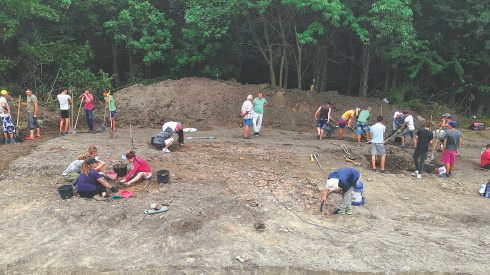

Meanwhile, a thorough understanding of Chinese cultural characteristics cannot be achieved without cross-cultural perspectives. Inspired by the Belt and Road Initiative, Romania, the homeland of the Cucuteni painted pottery, was selected as the first destination for Chinese archaeologists to gain their cross-cultural experience.
Romania, located in Southeast Europe and bound by the Black Sea to the east, has been a crossroads where objects and cultures have been exchanged, and populations have interacted, since prehistoric times. It occupies a strategic position in the so-called "Old Europe".
The peak of prehistoric civilizations in "Old Europe" is represented by the Cucuteni-Tripolye (or Trypillia in Ukraine) Culture, dating back between 7,000 and 5,500 years, spreading across present-day Romania and Ukraine. The site is located about 30 kilometers south of the city of Iasi.
Quite different from most Yangshao Culture sites in the Central Plains, most Cucuteni sites are situated at a much higher elevation. So is the site of Dobrovat in Romania. It is basically located on the top of a hill, overlooking a fertile river valley to the east. A significant distance to water sources apparently does not conform to the common wisdom for selecting a place to dwell.
The puzzle had been hovering until I found a spring in a small gully near the site in 2019. Based on current landscape, I can imagine that the forest must have been much thicker then, when the Cucuteni people settled here. Rich forest resources were used in the construction of their dwellings, daily cooking and pottery firing.
I, along with other Chinese colleagues, was welcomed by a renowned archaeologist couple based in Iasi, professors Magda and Gheorghe Lazarovici-both are in their 70s but still active in fieldwork. They spent their whole career in studying the Cucuteni Culture.
Magda told me that there are thousands of well-preserved archaeological sites like Dobrovat. Yet, only a small number were thoroughly excavated due to the shortage of research funds and qualified archaeologists.
I was shocked when I learned that, over the past decade, they had funded themselves and their excavations from their limited retirement pensions.
The goal of the fieldwork is to reveal a Cucuteni house abandoned around 6,300 years ago. As the top soil, about 20 centimeters thick, was removed, dense red-burned clay chunks were exposed. Most of them have a high degree of sintering and are pretty hard.